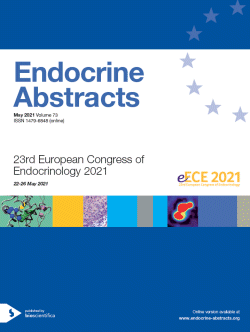
European Congress of Endocrinology 2021
Online
22 May 2021 - 26 May 2021
Oral Communications
Oral Communications 8: Pituitary and Neuroendocrinology
ea0073oc8.1 | Oral Communications 8: Pituitary and Neuroendocrinology | ECE2021
Expression and putative role of 14–3-3 proteins in corticotroph tumours
Tang Sicheng , Perez-Rivas Luis Gustavo , Albani Adriana , Rotermund Roman , Flitsch Jörg , Honegger Jürgen , Rachinger Walter , Sigrun Röber , Herms Jochen , Reincke Martin , Theodoropoulou Marily
ea0073oc8.2 | Oral Communications 8: Pituitary and Neuroendocrinology | ECE2021
Osilodrostat is an effective and well-tolerated treatment option for patients with Cushing’s disease (CD): Final results from the LINC3 study
Fleseriu Maria , Biller Beverly , Pivonello Rosario , Akira Shimatsu , Carla Scaroni , Belaya Zhanna , Vila Greisa , Houde Ghislaine , Walia Rama , Izquierdo Miguel , Roughton Michael , Pedroncelli Alberto , Newell-Price John
ea0073oc8.3 | Oral Communications 8: Pituitary and Neuroendocrinology | ECE2021
GFRα2 as a GPS marker: Role of GFRα2 in pituitary gland
Pradilla Dieste Alberto , García Lavandeira Montserrat , Pérez-Romero Sihara , Graça Fonseca Jesuina Arcángela , Kupari Jussi , Japón Miguel , Airaksinen Matti S. , Álvarez Clara V.
ea0073oc8.4 | Oral Communications 8: Pituitary and Neuroendocrinology | ECE2021
Novel insight into ACTH-secreting pituitary tumors biological behavior: hormone secretion and cell proliferation modulation by Ubiquitin Specific Peptidase 8 inhibitor RA-9
Di Muro Genesio , Treppiedi Donatella , Marra Giusy , Mangili Federica , Catalano Rosa , Barbieri Anna Maria , Locatelli Marco , Spada Anna , Arosio Maura , Mantovani Giovanna , Peverelli Erika
ea0073oc8.5 | Oral Communications 8: Pituitary and Neuroendocrinology | ECE2021
The clinical effects of miR-26a, miR-16, let-7, miR-128a and miR-223 in acromegaly patients
Cagrı Bosna Islam , Cinar Nese , Edgunlu Tuba , Akbaba Gulhan , Yaylali Guzin , Sevim Karakas Celik , Ebru Onalan Etem , Celik Aycan , Gizem Bircan Murside
ea0073oc8.6 | Oral Communications 8: Pituitary and Neuroendocrinology | ECE2021
Increased PCSK1N in silent corticotroph pituitary adenomas may explain their “silence”
Ringvoll Normann Kjersti , Kristin Berland Astrid Berland , Olsen Linn Guro , Lekva Tove , Dahlberg Daniel , Bollerslev Jens , Petter Berg Jens , Cristina Olarescu Nicoleta



